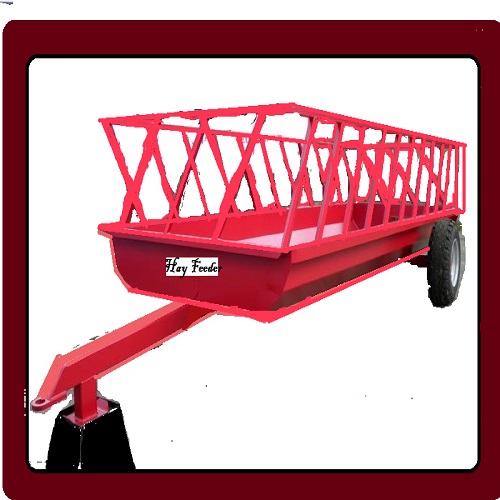Definition of Cattle Hay Feeder
These refer to farm implements or structures designed with either metal, wood, or polyethylene where hay is kept for feeding cattle.
The devices are constructed so that there are openings where the hay is kept, and the animal can easily access and eat hay from the feeder.
The hay feeder for cattle aims to reduce hay wastage as keeping hay on the ground, can lead to it being easily trampled, soiled, and scattered.
Hay is a type of dry forage purposely harvested and preserved for feeding cattle during the dry season when fresh forages are scarce.
The hay feeder plays a crucial role during this season when forages are scarce to minimize hay wastage.
There are many models of hay feeders designed to suit the needs of the production and reduce the wastage of feed. There are various forms of cattle hay feeders such as wall-mounted, portable, and mobile hay feeders.
Materials Used in the Construction of Cattle Hay Feeder.
Cattle hay feeders are constructed with different types of materials depending on the users’ choice and the nature of production. Some of the materials used in the construction of the Cattle Hay Feeder are;
- Plastic or Polyethylene: cattle hay Feeders are made of polyethylene or plastic material. Plastic or polyethylene materials are usually more expensive compared to wooden materials. These materials are sometimes easier to maintain since they don’t rust easily. They are most suitable for Do-it-yourself (DIY) cattle hay feeders.
- Metal or Galvanized steel: this is the most commonly used material for the construction of cattle hay feeders. It is more suitable for the construction of commercially used hay feeders. These types of materials are strong, durable, and easy to maintain. Metal feeders or galvanized steel feeders are generally more expensive compared to plastics and wooden materials.
- Wooden Materials: this type of material is mostly suitable for the construction of a Do-it-yourself (DIY) cattle hay feeder. It is the cheapest source of material for the construction of the cattle feeder. The wooden materials feeder is difficult to maintain as it is constructed which makes washing and cleaning difficult.
This might also interest you: Poultry feeder: Definition, Benefits, Factors to be Considered and 5 Types Poultry feeder
Factors to Consider in the Construction of Cattle Hay Feeder.
Hay feeders for cattle have been considered as one of the possible ways of reducing hay wastage and soiling.
Cattle are large ruminate animals with a lot of force so when constructing cattle feeders emphasis should be placed on materials that can withstand such power and force.
Some of the factors to consider in the construction of the cattle hay feeder should include:
- Durability: the durability of the cattle feeder in this context refers to the number of years used compared to the amount of capital invested in the construction. The hay feeders should be such that they can be used for a long period. Metal hay feeders have been reported to be more durable than polythene hay feeders. Though polythene hay feeders resist corrosive and rusting compared to metal but can easily be trampled and destroyed. Since the feeders are kept under open air, it is advisable to construct them with galvanized steel to prevent corrosion and rusting
- Cost-effectiveness: the cattle hay feeder to be constructed should be cost-effective. Though there are many models and improved hay feeders, whatever model and technologically improved type, it should be cheap and affordable. The cattle hay feeders should be constructed with materials that are not too expensive that the rancher and herder cannot afford.
- Maintenance factors: the materials used in the construction of the cattle hay feeders should be such that they can easily be maintained. Rough surface materials should be avoided. Galvanized steel cattle hay feeders are easy to wash and maintain.
- Size of the Herd: the size of the herd is another factor to consider in the construction of the cattle hay feeder. Small-sized herds of cattle require small numbers or sizes of feeders while large cattle herds require large numbers or sizes of feeders. The numbers of cattle in the ranch determine the size of the herd.
- Space Available: Another factor to be considered in the design of cattle hay feeders should be based on the space available. If the space available in the ranch is small, then the hay feeder should be constructed in an ailment with the available size to avoid overcrowding.
- Type of Hay to be Fed: the type of hay to be fed to the animal should be considered in the choice of the feeder construction.
Importance of Cattle Hay Feeder
In the Cattle Production industry, the importance of the hay feeder cannot be undervalued. Some of the notable importance of the hay feeders are:
- Reduce Feed Wastage: The hay feeder is usually constructed in a manner that prevents feed wastage. Since the hay is not kept on the floor for the animals, it will be difficult for them to be trampled and soiled thereby improving feeding efficiency. These specialized cattle feeding devices reduce trampling, soiling, and contaminations thereby creating avenues for adequate feed consumption.
- Reduce Feeding Cost: Well-constructed hay feeding devices help reduce the ranch’s feed cost by decreasing feed wastage. The cost of purchasing or importing hay will increase the overhead cost of production if feed is left unmanaged. Proper management of feeds will reduce the cost of purchasing feed, therefore creating an avenue for purchasing more feed for adequate feeding for the animal which increases the growth and productivity of the livestock.
- Aid Clean Feeding: the uses of these technology hay feeders promote clean feeding or eating since the feed is lifted above ground level. The hay feeder is designed to dispense hay to the animal in bits therefore preventing trampling and soiling. Disease infestation is possible with soiled and trampled hay, which can lead to serious health issues when consumed, however, the use of hay feeders promotes healthy feeding.
- Save Time and Labor: manually dispensing feed for cattle is time-consuming and stress-related. the advent of the cattle hay feeders saves time and labor as many cattle can be fed with few feeders. The use of the feeder is more efficient in feeding a large number of cattle with hay since It saves the time of manually attending to individual cows which is time time-consuming and involves a lot of drudgery.
- Manage Feed Intake: this device is constructed with a structure that prevents the animals from having unrestricted access to the feed. The feed in the hay feeders is dispensed gradually which helps to manage feed intake per time by the animal. Since the feed is dispensed in bites, the cows are prevented from overeating which leads to better health status among the animals.
- It Aids All Year round Feeding of Cattle: with the help of the hay feeder, many cattle can be fed all year. During the winter and summer, as the case may be, when forages are very scares, hay becomes the veritable source of feed for the animals, and a hay feeder can be a strong tool for better feeding management.
This might be useful to you: Top 6 Cattle Feed-Making Machines, Explanation, Merits and Demerits of Each Type of Machine
Types of Cattle Hay Feeder
There are various types of feeders used in the ranch for feeding cattle, the most commonly used types of cattle hay feeders are:
Bale Feeder
This is the most commonly used type of cattle feeder in the cattle production industry. The bale feeder comes in various designs depending on the needs of the rancher or herder.
Some models of the bale feeder are mobile or immobile (that is, built on location). Rectangular or circular. This type of feeder is usually constructed in such a way that it is lifted off the ground where cattle can easily access hay.
Metal-constructed bale structure is more durable, ability to withstand rough usage, and is easy to clean compared to other materials that could be used in the construction of the bale.
This type of cattle feeder is constructed with the base covered with flat pieces of metal, several side iron frames that are usually 50-60cm high with an open frame where multiple cattle can easily feed from the bale.
The bale is lifted from the ground surface with the aid of the side legs which are usually about 25-30cm from the ground surface.
Advantage of Bale Feeder
The following are the advantages of the cattle Bale feeder:
- It allows multiple cattle to feed at the same time.
- It helps to decrease feed wastage.
- It promotes clean and healthy feeding since cattle can feed directly on the hay without trampling and soiling.
- It creates room for good consumption of hay since the feed is lifted off the ground which helps to increase growth and productivity.
- It is usually suitable for industrial usage.
- It can be easily improvised
Disadvantage of Bale Feeder
The disadvantages of the cattle bale feeder are:
- Metal-constructed bale feeder requires technical skills.
- It posed a high risk of rusting and corroding.
- It is expensive to construct mostly those that are mobile.
Maintenance Practices of Bale Feeder
The following caution should be observed while using the Bale feeder;
- restrict cattle to the carrying capacity of the bale feeder.
- wash and dry the feeder properly to avoid rusting and corroding.
- mobile Bale feeders should have tire well gauges before moving.
- mobile Bale feeders should have all their moving parts well-oiled and greased
- Immobile cattle Bale feeder should be painted frequently to avoid rusting.
Hay Rack
The Hay Rack is made up of either metal, wood, or concrete and is usually attached to the wall or fence of the ranch. It may be circular, vertical, or rectangular depending on the choice and resources available to the rancher.
The concrete form of the hay rack is constructed on the floor with a flat base where cattle can easily pull out hay. The wall-mounted type of hay rack is usually constructed vertically with small, smooth iron bars with a nut to hold the hay rack to the wall.
The hay rack is usually suspended from the ground to prevent soiling.
Advantages of The Hay Rack
The following are the Advantages of the hay rack
- it keeps hay away from dirt
- it leaves hay from the ground surface which prevents moisture from affecting the hay
- it prevents hay from parasite infestations
- it helps to minimize waste since the cattle are allowed to pull hay from the rack
- it is usually suitable for small-scale ranchers.
- it is very cheap to construct
The disadvantage of Hay Rack
The disadvantages of the Hay Rack feeder are
- it is not suitable for commercial cattle farming
- concrete structure can serve as an obstruction to cattle and herder movement in the ranch.
- the concrete type can easily soil the cattle.
- The wall type can be pulled out by the cattle or firmly fixed to the wall.
Maintenance Practices of Hay Rack
The following caution should be observed while using the hay rack:
- restrict cattle to the carrying capacity of the hay rack.
- the concrete hay rack should be washed after use.
- wall-fixed hay rack feeders should be checked properly to avoid being pulled away by the animals.
- tighten the nuts and bolts of the wall rack regularly.
- metal forms of hay racks should be painted frequently to avoid rusting.
Hay Trailer Feeder

The hay trailer feeder is a tractor-mounted feeder that is usually moving around the pasture or ranch for the optimal feeding of cattle. It is made of a hopper, wheel, tire, welded steel, and drawbar. The hay trailer is constructed in such a way that it can be used to dispense hay to cattle. This type of cattle hay feeder is suitable for rotational grazing systems of cattle management.
Advantages of the Hay Trailer Feeder
The following are the advantages of the Hay trailer feeder
- It allows multiple cattle to feed at the same time.
- It minimized the wastage of feed.
- It promotes healthy feeding since cattle can pull hay directly without contamination.
- It creates room for good consumption of hay since every cattle has an equal chance of feeding which helps to increase growth and productivity.
- It is usually suitable for commercial cattle management.
Disadvantage of Hay Trailer Feeder
The disadvantages of the Hay trailer feeder are:
- It requires technical skills for construction.
- It posed a high risk of rusting and corroding.
- It is usually very expensive to purchase.
- It requires a tractor or mobile truck to move it around the ranch.
Maintenance Practices of Hay Trailer Feeder
The following caution should be observed while using a Hay trailer feeder
- Reduce cattle to the carrying capacity of the Hay trailer feeder.
- Wash and dry the feeder properly.
- The hay trailer feeder should have their tire well gauge before moving.
- The hay trailer feeder should have all their moving part oiled and greased.
- Metal parts should be painted frequently to avoid rusting and corrosion.
Ground Feeder
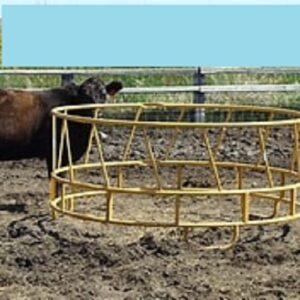
This is the simplest form of cattle feeder which is designed to enable cattle to pull hay from the feeder. It is usually circular like the ground bale feeder but different from the circular bale feeder in that the circular bale feed has its side covered with metal while suspended from the ground surface but the ground feeder has all its sides open except the frame that is used to construction the where cattle can easily pullout the hay.
Advantage of the Ground feeder
The following are the advantages of the Ground feeder
(1) It minimized the wastage of feed
(2) It creates room for good consumption of hay since there are few restrictions on hay consumption.
Disadvantage of Ground Feeder
The disadvantages of the ground feeder are:
- pathogens can easily infest the feed.
- It is not suitable for commercial usage.
- It posed a high risk of rusting and corroding
Maintenance Practices of Hay Trailer Feeder
The following caution should be observed while using a ground feeder Reduce cattle to the
- carrying capacity of the Hay trailer feeder
- Metal parts should be painted frequently to avoid rusting and corrosion.
- disinfect hay trailers regularly to avoid the outbreak of pests and diseases.
Cover Hay Feeder
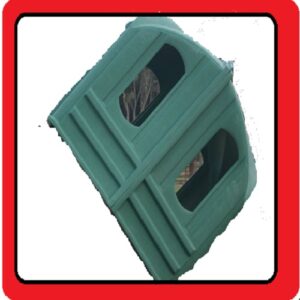
The cover hay feeder is also called the hay hut, it is made up of wood, metal, or plastic materials depending on the choice of the herder or the rancher. The covered hay feeder consists of a door or opening where the cattle can pull the hay for efficient consumption. It is called the cover hay feeder because the hay is rapped into bales and covered with the hay hut.
Advantage of the Cover Hay Feeder
The following are the advantages of the Cover hay feeder
- It allows multiple cattle to feed at the same time.
- It decreases feed wastage.
- It promotes healthy feeding since cattle can feed directly on the hay without trampling and soiling.
- It creates room for good consumption of hay since the feed is lifted off the ground.
- It is usually suitable for commercial cattle production.
Disadvantage of Cover Hay Feeder
The disadvantages of the Cover hay feeder
are
- It requires technical skills for construction.
- Metal types pose a high risk of rusting and corroding.
- It is usually very expensive to purchase.
Maintenance Practices of Cover Hay Feeder
The following caution should be observed while using a hay trailer feeder
- reduce cattle to the carrying capacity of the Cover hay feeder
- clean the inner chamber by removing the hut
- paint frequently for proper maintenance.
- fumigate the hut frequently to prevent harboring parasites.
Trough Feeders
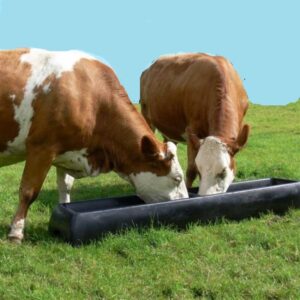
This is one of the most common types of feeders used in the cattle production industries. The trough feeder is made up of metal, plastic, or wooden material where cattle can easily feed on hay. Different types of trough hay feeders exist depending on the system of management. The trough is usually very long and is mounted on the pen where the animal can access hay.
Advantage of the Trough feeders
The following are the advantages of the trough feeders:
- It allows different numbers of cattle to feed Independently at the same time
- It helps to reduce feed wastage.
- It promotes healthy feeding since cattle can feed directly on the hay without trampling and soiling.
- It creates room for good consumption of hay since the feed is lifted off the ground which helps to increase growth and productivity.
- It is usually suitable for different types of management systems.
The disadvantage of Trough feeders
The disadvantages of the Trough feeders are:
- It can lead to wastage of feed if the cattle are not restricted.
- It requires little technical skills for construction.
- It can easily rust or corrode.
- Ease of maintenance
Maintenance Practices of Trough Feeders
The following caution should be observed while using Trough feeders
- Wash and dry the feeder properly.
- Replace broken or damaged feeders.
Adjustable Feeder
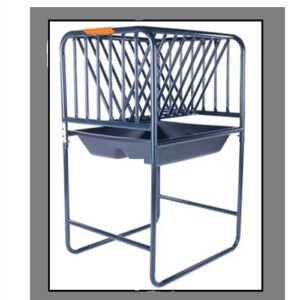
This is an improved forms of feeder that is made of metal which allow the rancher to adjust the feeder to cater to the needs of various categories of cattle. The feeder is made of a chamber, a flat metal pan, a protective frame, and an adjusting point.
The advantage of the Adjustable feeder
The following are the advantages of the Adjustable feeder
- It allows multiple cattle at the same time.
- It helps to reduce feed wastage.
- It promotes healthy feeding since cattle can feed directly on the hay without trampling and soiling.
- It creates room for good consumption of hay since the feed is lifted off the ground which helps to increase growth and productivity.
- It is usually suitable for different types of management systems.
Disadvantage of Adjustable feeder
The disadvantages of the Adjustable feeder are:
- It requires little technical skills for construction
- It can easily rust or corrode except for galvanized steel type.
- Ease of maintenance
Maintenance Practices of Adjustable Feeder
The following caution should be observed while using an Adjustable feeder
- wash and dry the feeder properly.
- replace broken or damaged feeders.
- greased and oiled adjustable parts
In conclusion
In this article, we clearly explain all the concepts of cattle hay feeder, the definition, benefits, factors to be considered, types, materials used, and the merits and demerits of each cattle hay feeder.
The best forms of feeders used in the commercial cattle industries include a bale feeder, adjuster feeder, trailer feeder, cover feeder, and trough feeder.
